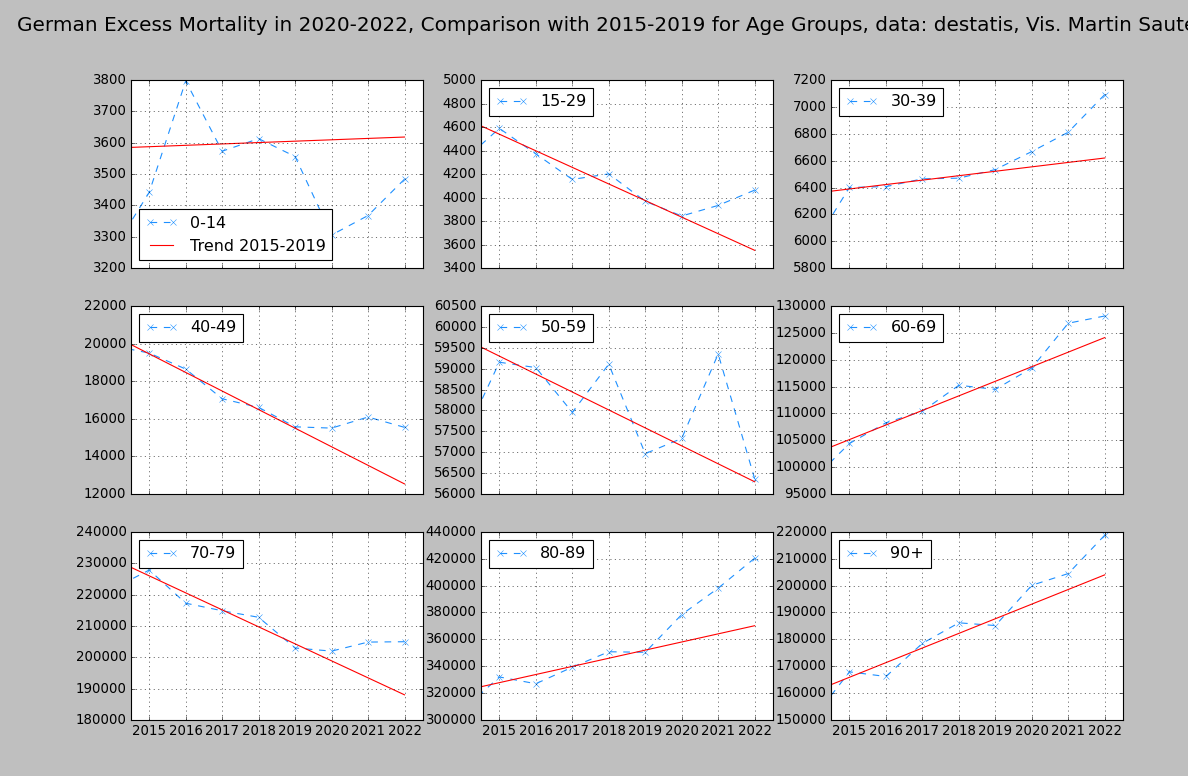
Tweeting about Excess Mortality, I sometimes encounter strong vibes by "liberal statisticians™" telling me of all my calculations are very, very bad and wrong 😱 because I do not consider aging of population.
(Short answer: Nope)
🧵
(Short answer: Nope)
🧵
https://twitter.com/Martin__Sauter/status/1629860673227304960?s=20
What I usually do: I calculate trend from death numbers - this is a very precise metric and I extrapolate by a linear model.
This works well, this can also be done by excel or other tools.
For Germany this looks as follows:
2/N
This works well, this can also be done by excel or other tools.
For Germany this looks as follows:
2/N

3/N "Age standardisation" is often told to be the "gold standard" for mortality metrics. You can find a description here:
health.mo.gov/data/mica/CDP_…
health.mo.gov/data/mica/CDP_…
4/N You calculate deaths per population for defined age bands. Afterwards you normalise these values to a "standard population" which you assume to be constant in the time interval you look at.
This means, that you assume age distribution to be constant during the time.
This means, that you assume age distribution to be constant during the time.
5/N Which means you "calibrate" out effects of population aging.
I took the data of two other mortality trackers and compared the deviation from predicted linear trend for the pandemic years.
I took the data of two other mortality trackers and compared the deviation from predicted linear trend for the pandemic years.
6/N For calculation I took a relative "overshoot" from the expected value (This term comes from signal processing but I think it can be understood quite intuitively)
7/N Look at this by @ProfStefanKraus (right picture) is age standardised mortaility rate, normalised to 2021. He uses german population from 2021 as standard. 

8/N Typing these values into my #python program I extrapolate as relative excess:
3.7% / 7.3% / 9.9%
3.7% / 7.3% / 9.9%

9/N which is even higher than the values I calculate from death numbers. Anyway, both calculations match quite well. 

11/N These values are quite different (pls note that here the last 3 weeks with a very many excess deaths are not within this graph)
12/N Paul @dobssi also was so kind to provide me with his calculations for Sweden (Thx for sharing #openscience !) Here come the calculations for death numbers, "crude" mortality and standardised mortality: 

13/N And we see: Extrapolation from ASMR and Death numbers come together very, very close.
14/N So we see, choice of standard population affects the calculated ASMR.
My suspicion is that the distribution in the age bands makes the difference.
My suspicion is that the distribution in the age bands makes the difference.
15/N What you calibrate away by using ASMR is the trend of shift in population towards older group. What you see afterwards is the effect of better life conditions and improved healthcare, which leads to a higher life expectancy.
16/N But this is not really necessary, because in 2020 to 2022 you have higher jumps in mortality due to the emergence of SarsCoV2. This effect is in the range of some percent and overrides slow happening demographic changes.
17/N So: There is no real necessity to do an ASMR calculation for estimating pandemic effects on excess mortality. All background demographic effects are included in the slope of death numbers and can easily be extrapolated.
//
//
• • •
Missing some Tweet in this thread? You can try to
force a refresh











